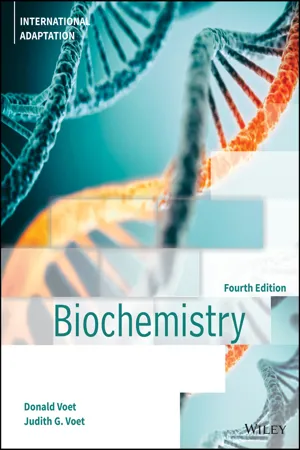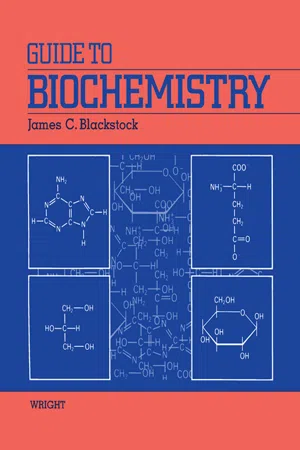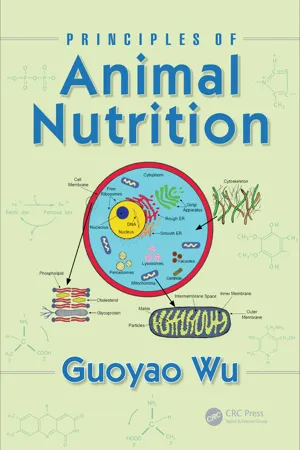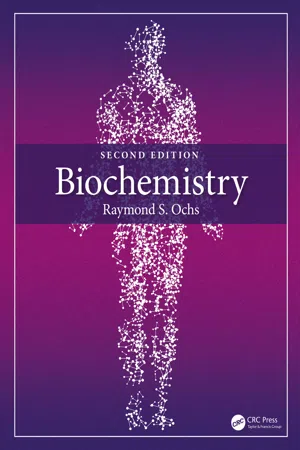Chemistry
Properties of Amino Acids
Amino acids are the building blocks of proteins and contain an amino group, a carboxyl group, and a side chain. They are characterized by their unique side chains, which determine their chemical properties. Amino acids can be classified as polar, nonpolar, acidic, or basic based on the nature of their side chains, and these properties influence their role in protein structure and function.
Written by Perlego with AI-assistance
Related key terms
Related key terms
1 of 4
Related key terms
1 of 3
12 Key excerpts on "Properties of Amino Acids"
- eBook - ePub
- Donald Voet, Judith G. Voet(Authors)
- 2021(Publication Date)
- Wiley(Publisher)
Chapter 3 Amino Acids1 The Amino Acids of ProteinsA. General PropertiesB. Peptide BondsC. Nomenclature of Amino AcidsD. Classification and Characteristics2 Stereochemistry of Amino AcidsA. An Operational ClassificationB. The Fischer ConventionC. The Cahn–Ingold–Prelog SystemD. Chirality and Biochemistry3 Chemical Properties of Amino AcidsA. Acid–Base PropertiesB. Reactions of Amino Acids4 “Nonstandard” Amino AcidsA. Amino Acid Derivatives in ProteinsB. Specialized Roles of Amino AcidsIt is hardly surprising that much of the early biochemical research was concerned with the study of proteins. Proteins form the class of biological macromolecules that have the most well-defined physicochemical properties, and consequently they were generally easier to isolate and characterize than nucleic acids, polysaccharides, or lipids. Furthermore, proteins, particularly in the form of enzymes, have obvious biochemical functions. The central role that proteins play in biological processes has therefore been recognized since the earliest days of biochemistry. In contrast, the task of nucleic acids in the transmission and expression of genetic information was not realized until the late 1940s and their catalytic function only began to come to light in the 1980s, the role of lipids in biological membranes was not appreciated until the 1960s, and the biological functions of polysaccharides are still somewhat mysterious.In this chapter we study the structures and properties of the monomeric units of proteins, the amino acids. It is from these substances that proteins are synthesized through processes that we discuss in Chapter 27 . Amino acids are also energy metabolites and, in animals, many of them are essential nutrients (Chapter 23 - eBook - ePub
- James C. Blackstock(Author)
- 2014(Publication Date)
- Butterworth-Heinemann(Publisher)
Today the immense variety of protein molecules is recognized. Proteins are the most abundant macromolecules found within cells and perform a wide variety of functions (Section 1.6). A protein can be considered as a unique polymer of amino acids (Section 1.4) which determine its chemical and structural properties. It is therefore imperative to consider the amino acids before embarkation upon a discussion of protein structure. Of the 308 catalogued natural amino acids, only 20 (plus a few derivatives) occur in proteins in which all are α-amino acids of the L -series (Section 1.3). They conform (except proline) to a general formula (Figure 4.1) in which an amino group and a carboxylic acid group are attached to the α-carbon (C α) atom. Proline, an imino acid, is normally included because of its occurrence in proteins. The properties of individual amino acids vary according to the nature of the R group called the side chain (Table 4.1). Asparagine and glutamine are considered as amide derivatives of aspartic acid and glutamic acid respectively. Tyrosine may be classified either by its hydroxy or aromatic group. To refer to amino acids in polypeptide sequences, three- or one-letter codes are frequently employed. L -α-Amino acids, with the exception of glycine, contain a chiral α-carbon atom (Section 1.3). These amino acids exhibit optical activity; in some cases, dextrorotatory, e.g. alanine, in other cases laevorotatory, e.g. phenylalanine. Because of the conjugated double-bond system of their aromatic rings, tyrosine, tryptophan and phenylalanine absorb light in the ultraviolet region - eBook - ePub
Fundamentals of Biochemistry, Integrated E-Text with E-Student Companion
Life at the Molecular Level
- Donald Voet, Judith G. Voet, Charlotte W. Pratt(Authors)
- 2017(Publication Date)
- Wiley(Publisher)
Section 1-1A ). Amino acids, as ancient and ubiquitous molecules, have been co-opted by evolution for a variety of purposes in living systems. We begin this chapter by discussing the structures and chemical properties of the common amino acids, including their stereochemistry, and end with a brief summary of the structures and functions of some related compounds.1 Amino Acid Structure
KEY CONCEPTS
- The 20 standard amino acids share a common structure but differ in their side chains.
- Peptide bonds link amino acid residues in a polypeptide.
- Some amino acid side chains contain ionizable groups whose pK values may vary.
The analyses of a vast number of proteins from almost every conceivable source have shown that all proteins are composed of 20 “standard” amino acids. Not every protein contains all 20 types of amino acids, but most proteins contain most, if not all, of the 20 types.The common amino acids are known asα-amino acidsbecause they have a primary amino group (—NH 2) as a substituent of theα carbonatom, the carbon next to the carboxylic acid group (—COOH;Fig. 4-1). The sole exception is proline, which has a secondary amino group (—NH—), although for uniformity we will refer to proline as an α-amino acid. The 20 standard amino acids differ in the structures of their side chains (R groups). Table 4-1 displays the names and complete chemical structures of the 20 standard amino acids.FIG. 4-1 - eBook - ePub
- Guoyao Wu(Author)
- 2017(Publication Date)
- CRC Press(Publisher)
4 Chemistry of Protein and Amino AcidsThe word “protein” originated from the Greek word “proteios ,” meaning prime or primary (Meister 1965). A protein is a large polymer of amino acids (AAs) linked via the peptide bond (–CO–NH–). Different proteins have different chemical properties (e.g., AA sequences, molecular weights, ionic charges, three-dimensional (3D) structures, hydrophobicity, and function). The general structure of an AA is shown in Figure 4.1 . There may be one or more polypeptide chains in a protein, which contains its constituents (nitrogen, carbon, oxygen, hydrogen, and sulfur atoms). A protein may be covalently bonded to other atoms and molecules (e.g., phosphates) and non-covalently attached with minerals (e.g., calcium, iron, copper, zinc, magnesium, and manganese), certain vitamins (e.g., vitamin B6 , vitamin B12 , and lipid-soluble vitamins), and/or lipids. Protein is the major nitrogenous macronutrient in foods and the fundamental component of animal tissues (Wu 2016). It has structural, signaling, and physiological functions in animals (Table 4.1 ).Figure 4.1 Fisher projections for configurations of AAs relative to l - and d -glyceraldehydes. The general structure of an AA in the non-ionized form is shown. For AAs, l - or d -isomers refer only to the chemical configuration of their α - eBook - ePub
- Rickey Y. Yada(Author)
- 2017(Publication Date)
- Woodhead Publishing(Publisher)
1Properties of proteins in food systems: An introduction
E.C.Y. Li-Chan; I.M.E. Lacroix The University of British Columbia, Vancouver, BC, CanadaAbstract
Proteins play a fundamental role not only in sustaining life, but also in foods derived from plants and animals. Foods vary in their protein content, and even more so in the properties of those proteins. In addition to their contribution to the nutritional properties of foods through the provision of amino acids that are essential to human growth and maintenance, proteins impart the structural basis for various functional properties of foods. This chapter provides an introduction to the basic chemical and physical properties of proteins and their amino acid building blocks. It then provides an overview of the molecular forces involved in protein structure, and the various factors that can influence the properties of proteins in food systems, including interactions with food constituents, food processes, and external conditions, chemical derivatizations, and enzymatic modifications. Finally, it highlights the current trends in food protein research.Keywords
Amino acids; Protein structure; Molecular Forces; Functional properties; Protein interactions; Food processes; Protein modification; Food protein research trends.1.1 Introduction
The word “protein” is defined asany of a group of complex organic compounds, consisting essentially of combinations of amino acids in peptide linkages, that contain carbon, hydrogen, oxygen, nitrogen, and usually, sulfur. Widely distributed in plants and animals, proteins are the principal constituent of the protoplasm of all cells and are essential to life. (Going back to a Greek word meaning 'first' or 'primary;' because of the fundamental role of proteins in sustaining life.)(Morris, 1992 )Proteins play a fundamental role not only in sustaining life, but also in foods derived from plants and animals. Foods vary in their protein content (Table 1.1 - eBook - ePub
Understanding Advanced Organic and Analytical Chemistry
The Learner's ApproachRevised Edition
- Kim Seng Chan, Jeanne Tan;;;(Authors)
- 2016(Publication Date)
- WS EDUCATION(Publisher)
CHAPTER 12
Amino Acids
12.1 Introduction
Amino acids are organic compounds that contain both an acidic carboxyl group (–COOH) and a basic amine group (–NH2 ). α-amino acids have both these functional groups attached to the same C atom, known as the α-carbon, and their general formula is RCH(NH2 )COOH.Q:What is an α-carbon?A:α-carbon refers to the first carbon atom that is bonded to a functional group, such as –COOH, –OH, –Cl, –NH2 , –CHO, –COOR, etc. In the case of an amino acid, there are two functional groups, namely the –COOH and –NH2 . Since –COOH has a higher priority than –NH2 , the parent is an acid. The amine group being considered as a substituent is given the prefix, amino. The next carbon atom that is bonded to the α-carbon is known as β-carbon and the following one is the γ-carbon, so on and so forth.Accordingly, the differences among these α-amino acids lie with the type of side chain (R-group) that is attached to the α-carbon. When the R group is an H atom, we have the simplest α-amino acid known as glycine.Apart from glycine, an important feature of the α-carbon of the other amino acids is that the α-carbon is chiral in nature, and this causes them to be optically active and thus exist as a pair of enantiomers.Just like the use of Lego building blocks in creating structures of unique features, different combinations of amino acids in linear chains result in various types of proteins and polypeptides. The proteins and polypeptides in the human body are essentially derived from twenty α - eBook - ePub
- Pieter Walstra(Author)
- 2002(Publication Date)
- CRC Press(Publisher)
Gels are discussed in Section 17.2. In the present chapter, protein solubility, conformation, and conformational stability are the main subjects. See Chapter 8 for water relations. 7.1 DESCRIPTION The chemistry of proteins is covered in most texts on food chemistry and, of course, on biochemistry. For the convenience of the reader, a brief review is given in this section. 7.1.1 Amino Acids Proteins are linear polymers of á–L amino acids linked by the formation of peptide bonds: The degree of polymerization n ranges from 50 to several 100. R denotes a side group; basically 20 different ones exist in nature and are given in Table 7.1, together with some properties. According to the side group, they can be categorized as Aliphatic: Ala, Val, Leu, Ile Aromatic: Phe, Tyr, Trp, His Charged: Asp-, Glu-, Lys+, Arg+, His+, (Cys-) Somewhat polar, uncharged: Asn, Gln, Ser, Thr, (Tyr) Sulfur containing: Cys, Met This leaves Gly, which has a mere—H as a side group, and proline, which is not a primary amino acid. Note Proline is commonly called an imino acid, although it does not contain an imino group, C=NH, but a secondary amino group, C—NH— C. Note that some belong to more than one category. TABLE 7.1 Properties of Amino Acid Residues Other side groups occur when the protein is conjugated, implying that other groups become covalently bonded to some amino acid residues. This may concern phosphorylation (mostly of Ser or Thr); glycosylation, which takes many forms; hydroxylation (mostly of Pro or Lys); as well as attachment of some other groups. One thus commonly speaks of the conjugated phosphoproteins and glycoproteins; the latter may contain a wide variety of glucide groups, from one per molecule to several times 10% by mass. Metalloproteins contain one or more, bivalent or trivalent, cations, that are tightly bound, but not by covalent bonds; in other words, they are not part of the protein, though the biological function of the protein generally depends on their presence - eBook - ePub
- Ian W. Hamley(Author)
- 2020(Publication Date)
- Wiley(Publisher)
1 Basic Properties1.1 INTRODUCTION
Peptides and proteins are essential biological molecules and assemblies, and many structures and functions of organisms are derived by using them. Peptides and proteins comprise chains of amino acids and are produced from DNA in the ribosome via messenger RNA through three‐letter codons, i.e. each amino acid is represented by a triplet of nucleotides. Peptides are also known as ‘polypeptides’ to signify that they are polymers formed of amino acids. In fact, short peptides as considered in this book have the properties of oligomers rather than polymers.Although there is no rigorous definition of the difference between peptides and proteins in this book, a typical peptide would have up to 100 residues, and longer chains would be considered proteins. In fact, standard synthesis methods lead to peptides up to 50–60 residues in length, which may also be considered a cut‐off, with somewhat larger chains being described as ‘mini‐proteins’.This chapter is organized as follows. In Section 1.2 , the essential properties of the 20 standard natural amino acids that peptides and proteins are built from are first considered, including an analysis of reactivity, charge, and hydrophobicity. When incorporated in a peptide or protein, the term ‘residue’ is used for the group formed from the corresponding amino acid. Non‐natural residues that are found in a few natural and synthetic peptides are also introduced in Section 1.2 , especially those which are mentioned in peptide sequences elsewhere in this book. Then, in Section 1.3 , the nature and geometry of the peptide bond are considered. The main secondary structures adopted by peptides are discussed in Section 1.4 . There follows (Section 1.5 - eBook - ePub
Food Protein Chemistry
An Introduction for Food Scientists
- Joe Regenstein(Author)
- 2012(Publication Date)
- Academic Press(Publisher)
The degree of reaction is often different in the free amino acids because of the zwitterion nature of the compound. (Zwitterions do not exist in the middle of the protein because the free α -carboxyl and the free α -amino are lost in formation of the protein.) A detailed listing of some individual chemical reactions of amino acids can be found in Appendix 4-2. ACID–BASE PROPERTIES The isoelectric point of an amino acid is the point at which the amino acid has no net electrical charge. It is an important characteristic for any amino acid, because every amino acid has at least two acid–base (titratable) groups. This definition of an isoelectric point is an operational definition, that is, one that specifies an experiment and a particular result which then constitute the defined term. Clearly, the definition depends on the clarity and specificity of the experimental description and results as well as on the accuracy and precision with which the experiment can be done. (Define the difference between accuracy and precision.) Another important property of an amino acid is the association constant of the individual reactive groups. This is usually expressed as a p K, the negative log of K (the dissociation constant). These numbers change as the solution conditions change. It may be helpful to review a few concepts about acids and bases before beginning the more detailed discussion of isoelectric points and p K values. Our first problem is that of nomenclature. Strictly speaking, —CO 2 – and —NH 2 are bases because each of these groups can accept a hydrogen ion. However, the carboxyl group is usually considered acidic and the amino group basic. This is based on the fact that the p K of the carboxyl group is on the acid side of neutral and the p K of the amino group is on the alkaline side. Each acid–base pair must have an acid and a conjugate base (or a base and conjugate acid) - eBook - ePub
Wheat
Chemistry and Utilization
- Hugh Cornell, Albert W. Hoveling(Authors)
- 2020(Publication Date)
- CRC Press(Publisher)
On the other hand, basic amino acids such as lysine (pI=9.7) have high pI values, while the neutral ones such as glycine have pIs of about 6. The latter group of amino acids is by far the largest one. Table 7.1 shows the structures and molecular weights of 20 natural amino acids, together with their abbreviations, both according to the older three-letter system and the newer single-letter system, which is more convenient for showing the primary structure of the largest peptides and proteins. TABLE 7.1 The Naturally Occurring Amino Acids. Name Abbreviations Structure Molecular Weight Alanine Ala (A) 89 Asparagine Asn (N) 132 Cysteine * Cys (C) 121 Glutamine GIn (Q) 146 Glycine Gly(G) 75 Isoleucine † Ile (I) 131 Leucine † Leu (L) 131 Methionine * † Met (M) 149 Phenylalanine † Phe (F) 165 Proline Pro (P) 115 Serine Ser(S) 105 Threonine Thr(T) 119 Tryptophan † Trp. (W) 204 Tyrosine Tyr (Y) 181 Valine † Val (V) 117 Acidic Amino Acids Aspartic Acid Asp (D) 133 Glutamic Acid Glu (E) 147 Basic Amino Acids Arginine † Arg (R) 174 Histidine † His (H) 155 Lysine † Lys (K) 146 * Denotes sulfur-containing amino acids. † Denotes essential amino acids. 7.1.1 Properties of Amino Acids Amino acids are colorless, crystalline solids of high melting point (>200°C). They are moderately to highly soluble in water, but not so soluble in ethanol, diethyl ether, or benzene. These properties reflect the saltlike character of amino acids brought about by the presence of zwitterions. Because of the presence of basic and acidic groups, they are referred to as being “amphoteric.” Besides the acidic neutral and basic nature of amino acids, as indicated from their isoelectric points, the other important feature is the hydrophilicity or hydrophobicity of their side chains. From thermodynamic data, glutamine can be regarded as having the most hydrophilic (polar) side chain. The large hydrocarbon side chain of isoleucine is, of course, the reason for its hydrophobicity - eBook - ePub
- Raymond S. Ochs(Author)
- 2021(Publication Date)
- CRC Press(Publisher)
5 Amino Acids and ProteinsThe word protein is of Greek origin, meaning “first place” or primary. Berzelius originated this term in 1838 to identify a substance found in plant fibers essential for animal nutrition. This identification was well before the molecular nature of proteins was discovered. Proteins are the most diverse of biomolecules. They include structural proteins (such as the plant fibers), binding proteins (such as hemoglobin), and enzymes (such as sucrase). In this chapter, we examine protein structure and some elements of their binding behavior. In the next, we examine their function as enzymes. The proteins also play a central role in all subsequent chapters of the book, commensurate with their paramount importance in biochemistry.5.1 Common Structure of the Amino Acids
All amino acids contain an amine group (most commonly a primary amine) and a carboxyl group (the acid portion) attached to the same carbon. The latter is called the α-carbon, from an organic chemistry nomenclature system that assigns Greek letters to carbons adjacent to carboxyl groups: α, β, etc (Figure 5.1 ). Note that this is a distinctive use of the Greek lettering system from the carbohydrates. Also bound to the α-carbon is a hydrogen atom (the α-hydrogen) and a variable group designated as R (Figure 5.2 ). Twenty different R groups make up the common amino acids, meaning those incorporated into proteins. Except for glycine (for which R is a hydrogen atom), the α-carbon is chiral and designated as l or d by comparison to the reference molecule glyceraldehyde, illustrated in Figure 5.3 for the case of alanine (in which R is –CH3 ). The carboxyl group of alanine is most similar to the carbonyl group of glyceraldehyde. The amine group of alanine is most similar to the OH group of glyceraldehyde. In nature, virtually all amino acids are present in the l form.FIGURE 5.1 - eBook - ePub
Biochemistry Explained
A Practical Guide to Learning Biochemistry
- Thomas Millar(Author)
- 2018(Publication Date)
- CRC Press(Publisher)
4 Amino Acids and their Functions In this chapter you will learn:- the functional groups: an amine and carboxyl groups
- to understand the general structure of amino acid
- the structures, names and single letter symbols for the 20 amino acids found in proteins
- how 2 cysteines may be oxidised to form the bridging amino acid cystine
- how the carbons of amino acids are named or numbered
- the terms ampholyte and zwitterion and how these relate to amino acids
- the structure of an amide bond and the special case a peptide bond
- special functions of amino acids (e.g. neurotransmitters) and structural relationships between amino acids
- how ketones are formed from amino acids by removing ammonia from the αC
- the synthesis of the bioactive amines dopamine, noradrenaline, adrenaline and serotonin.
- to understand the basis for Parkinson’s disease and phenylketonuria
- that tyrosine, serine and threonine are phosphorylation sites in proteins
- the importance of decarboxylation in the formation of some active amines such as histamine
- how sugars may attach to the amino acids serine, threonine and asparagine
The name amino acid suggests that these structures have an amine and an acid group. Indeed this is true; amino acids have an amino group and a carboxylic acid. The structure of a typical L-amino acid is illustrated below. This type of amino acid is the basis of proteins.Basic structure and nomencalture of amino acids
Q&A 1 : Draw the chemical structures of a carboxylic acid, and an amine group.There is a central carbon that has bonds to an amine group, a carboxylic acid, an hydrogen and a variable R group. Since this central carbon has 4 different groups attached to it, it is a chiral carbon and hence there are 2 possible isomers, L and D. Nearly all amino acids in biochemistry are of the L-form (L for life). Note that this is the opposite of sugars, which nearly always occur as the D isomer. You need to learn their structure in this orientation. Remember that the L designation has nothing to do with the way they rotate polarised light, but is purely structural. This is based on the structure of L-glyceraldehyde.
Index pages curate the most relevant extracts from our library of academic textbooks. They’ve been created using an in-house natural language model (NLM), each adding context and meaning to key research topics.
Explore more topic indexes
Explore more topic indexes
1 of 6
Explore more topic indexes
1 of 4











